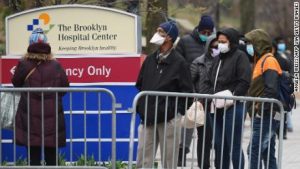In the next few days, California is likely to reach a grim milestone of 5,000 deaths from the new coronavirus, while the state also came close Wednesday to recording 140,000 total cases.
With 108 new COVID-19-related deaths reported Wednesday, the state death toll reached 4,854, according to data compiled by this news organization. The seven-day average for new deaths is 67, meaning this milestone could be reached by the weekend.
The number of new COVID-19 cases statewide also continues to surge, with 2,871 new infections recorded Wednesday. This number represents a seven-day average of 2,863 new cases, the highest-ever seven-day average since the start of the pandemic. The previous seven-day peak was reached on Tuesday at 2,785.
This continued rise in cases comes as individual counties, including several in the Bay Area, move further into Phase 2 of reopening their local economies. Phase 2, part of Gov. Gavin Newsom’s four-phase plan to reopen California, allows curbside retail, manufacturing, business offices and some other services to reopen. Santa Clara, Contra Costa and San Mateo also have told established restaurants they can seat diners at outside tables, as long as they enforce social distancing rules.
But similar to the state, the Bay Area is seeing a surge in new cases. The nine Bay Area counties, plus Santa Cruz County, recorded more than 163 new COVID-19 cases Wednesday. This number represents a seven-day average of 249 new cases, the highest-ever seven-day average since the pandemic began.
With three new deaths, all reported in Alameda County, the Bay Area’s death toll reached 480. However, the pace of deaths has seen a steady decline since April 22, when the 10 counties reported 21 deaths that day.
Some counties around the state may begin to move into Phase 3 on Friday, as long as they show they are equipped to handle a surge in cases and have mitigation efforts in place to reduce COVID-19 transmissions. Phase 3 allows the reopening of gyms, bars, campgrounds, professional sports and a wide range of businesses.
Newsom has offered reassurances that the state is better prepared to handle the spread of COVID-19 than when a statewide shelter-in-place order was implemented March 19.
During a meeting with community leaders in Oakland Tuesday, Newsom explained to a pool reporter that the state expects to continue to see an increase in the number of positive cases. But he also said “we are in a substantially different place than we were 90 days ago. We have hundreds of millions of masks now in our possession.”
Newsom also explained that California has increased its testing capacity — more than 60,000 tests per day compared with just 2,000 per day two months earlier. As of Wednesday, more than 1.8 million tests had been conducted in the state. The increase in testing allows health officials to closely monitor the rate of positive tests.
Officials also keep a close watch on the number of people hospitalized with confirmed or suspected cases of COVID-19, Newsom said. The number increased slightly to 4,719 on Tuesday, the first time more than 4,700 people have been hospitalized since May 21. But Newsom said the increase in in-patients is not yet a cause for concern.
The surge in new cases in California is largely taking place in hard-hit Los Angeles County, as well as in more remote Riverside and Imperial counties. Some 67,000 cases, 48% of the California’s total, have been reported in Los Angeles County.
Riverside, meanwhile, reported 321 new cases Wednesday, the second-highest number of new cases in the state, bringing its overall total to 9911. Riverside’s surge has been attributed to positive tests recorded at Chuckawalla Valley State Prison, where 986 inmates tested positive as of last weekend, the Desert Sun reported.
Meanwhile, there were 253 new cases recorded in rural Imperial County, bringing its total to 3,386. Since June 3, Imperial County has recorded 1,588 new cases. With a population of around 200,000, Imperial County also has the state’s highest rate of infection per 100,000 people.
Because Imperial County lies along the border with Mexico, health officials say the county’s surge in COVID-19 cases is largely due to American citizens and green card holders seeking health care across the border in the United States.
Staff writer Kerry Crowley contributed to this report.



















